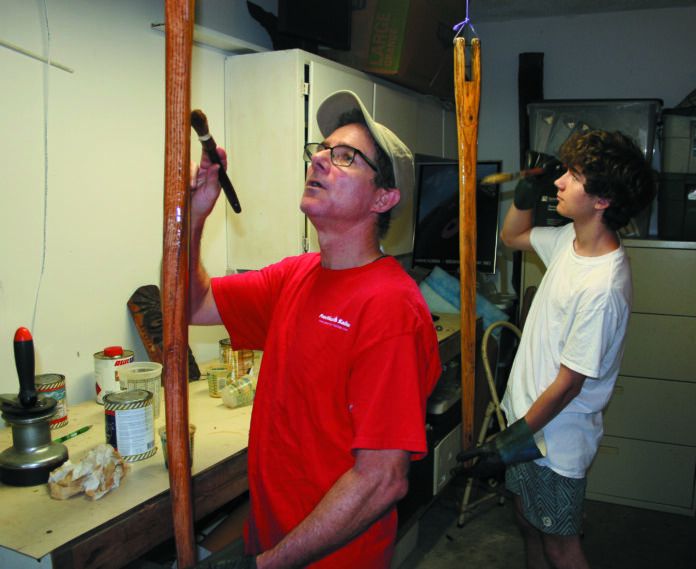What a difference a year makes! Last year, Practical Sailor testers were holed up in their home workshops, garages, basements, and home offices, meeting remotely on Zoom, and trying to do their part to stamp out a global pandemic. This year, they’re holed up in their home workshops, garages, basements and home offices, meeting remotely on ZOOM, scratching their heads and wondering what madness has overcome the dirt dwellers this time.
Obviously, with Practical Sailor’s emphasis on the scientific method when evaluating products, our staff is chagrined that the terrestrial folk have allowed the pandemic resurge again this summer, but we didn’t let that get in the way of our testing program. Unfortunately, some things were out of our control. Like many, we had our project delayed by not enough widgets arriving in factories, and not enough workers arriving in widget factories, and sudden surge in demands for the products the widgets comprise.
Some of our bigger tests were delayed by supply chain issues, which have impacted nearly every marine business. The supply problem has been especially acute for boatbuilders, who are experiencing an unexpected growth in sales. Most believe that the boat-buying boom is being driven by the dream of a disease-free island escape, or the carpe diem mentality that takes hold when life’s brevity smacks us in the face. Our view is that between the growing concern about pressures on the planet, and the previously accepted pressures on the soul, sailing is approaching a new golden age. Whatever the case, it’s a good time to be selling boats and gear, and not a great time for the bargain hunter. We do expect the used sailboat market to let off a bit of steam in the year ahead, as dreamers suddenly confront the realities of dealing with a fixer-upper. Then again, we know very few people who’d rather be minding an office cubicle than fiddling with their boat, so this mini-boom could carry on for a while.
BROAD MARKET NEWS
As for innovation and changes in the market, two things are worth mentioning. Satellite communication is gradually becoming a mainstream accessory among offshore cruisers. Antennas are getting smaller, pocket communicators are becoming smarter and more sophisticated and air time is getting cheaper. We touched on this in a couple of reports last year on weather routing and safety at sea, and you can expect much more in the year ahead, as a slew of pocket-sized communicators are popping up on store shelves.
The other big news that will impact PS readers, is in the coatings arena. Akzo Nobel, the Dutch based multinational parent company of Interlux, International, and US Paints (Awlgrip), went on a bit of buying spree in 2020-21. Most recently, it acquired New Nautical Coatings, makers of Sea Hawk paints. Established in 1978, Clearwater, Florida-based Seahawk has grown to become a dominant player in the U.S. and Caribbean market. Its products have fared well in past Practical Sailor antifouling tests and the company’s hold on the market was strong enough that it was able to bounce back from more than $1 million dollar fines and jail time for its executives resulting from a serious run-in with the EPA.
According to Matt Anzardo, a segment manager for Akzo Nobel, the Sea Hawk and Bluewater brand paints will operate as semi-autonomous units. Except perhaps for some label tweaks, we suspect consumers will probably not even notice the change—at least until the prices tick upward. With just two companies dominating the antifouling market in the U.S., we’re not hopeful that this narrow competition will be enough to keep the price down in the leisure market.
GEAR OF THE YEAR
Once more, the bulk of the past year’s testing focused on maintenance products, safety essentials, and do-it-yourself substitutes for higher priced marine gear. This approach to experimental testing served us well during the pandemic, and reader response has shown that sailors truly appreciate our efforts to buck the trend toward high-priced, budget-busting nonessential accessories or “marine grade” gear whose only distinction from cheaper products is the “marine” label.
Truth is, after nearly 50 years in the marine product testing business, we’ve already tested and reported on most of the products sailors need for their boats, and those reports can be found in our archives. The recent revolutions in anchor design and rope technology have been well covered during the past year. The next big thing on the horizon is, as mentioned, satellite communications and other electronics. We’re also in the midst of several reports on electric propulsion and energy storage.
MOB+
Our report on automated man overboard alerts and response devices coincided with a terrible tragedy in our home waters involving a student sailor who fell overboard and was injured by an outboard propeller – just the sort of accident the Fells Marine MOB+ and others like it were designed to prevent.
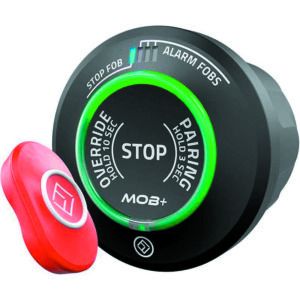
We tested several different wearable devices or fobs that took different approaches to the automated response when a passenger or driver falls out of their outboard driven dinghy. Some were activated by immersion, some were activated when the fob was no longer within a certain distance of a base unit on the boat. Preventing false alarm was one of the main challenges.
Fell Marine solved the false alarm puzzle with a signal protocol they call Wimea. Like all of the systems we tested, it raises an alarm and cuts off the motor if the sensor moves more than 50-150 feet from the boat. The alert is also triggered when the sensor submerges. Up to four additional fobs can be paired with the hub, creating alarms for passengers and engine stop for the primary operator. The idea, of course, is to give the operator better control of the situation. If the operator is still at the helm—and thus able to assist in the rescue—the boat won’t automatically stop, as many systems, do to avoid the “circle of death” of a driverless boat. If operators change, they can exchange fobs. If the operator position is more fluid, changing frequently, this could be a problem.
The Fells marine device was our Best Choice for a small outboard-driven fishing boat or a dinghy equipped with an older engine that lacks an automatic cutoff. In our view, the basic mechanical cutoff device —a wrist lanyard connected to a clip that retains the “Stop” button. This, in our view, is still the most effective choice for dinghies.
SEA-DOG WATERTIGHT CONNECTORS
Over the years, Sea-Dog line has become a prominent supplier of deck hardware and boat bits. You’ll see their displays in just about every marine chandlery. The quality can vary greatly among its line of products, and in previous tests they’ve landed in the middle of the pack, so we were a little surprised when its modestly priced watertight connector rose (or sank, in this case) to the top of the field.
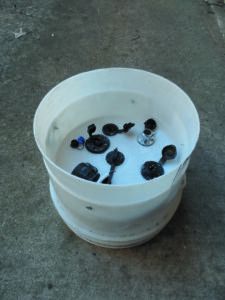
the Sea-Dog Watertight Connector (inset) proved to be a secure and affordable connector for deck accessories.
Inexpensive is not always cheap. In this case, the very affordable Sea-Dog watertight connector is an excellent choice for watertight plugs on deck.
MARINE GOLDSHIELD GS75
Drysuits are another innovation that have transformed offshore sailing. Previously reserved for “wet” sports like coldwater kayaking and dinghy racing, they are making their way onto bigger boats in lieu of heavy and often leaky foul weather gear. The trouble is, they tend to collect body odor and can really stink. Thus, our search for a potent, yet safe anti-microbial treatment.
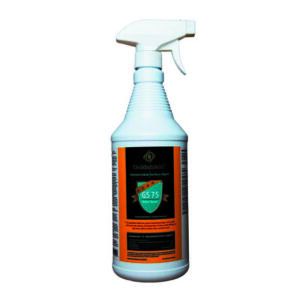
Although we are still big fans of our DIY formula A and Formula B, but the treatment doesn’t hold up well against water (see the Inside PS blog post “DIY Mildew Preventers that Really Work”). So, our search for controlling drysuit odor led us back to an anti-microbrial GoldShield. In its search for durable antimicrobial treatments Dow Chemical began researching organosilane chemistry more than 50 years ago, and some chemists at Emory University picked up the trail about 10 years ago and patented the formula as GoldShield. A second cousin to benzalkonium chloride (BAC) and more closely related to the Microban Aegis Microbe-Shield system, GoldShield resists wash off, so you don’t need to retreat every time you wash. It’s not cheap, so save the leftovers for next treatment. Better yet, dilute it a little more when you mix it into a spray bottle.
This is our Best Choice among offthe- shelf products for lasting odor control in dry suits. If you’d rather not pony up the $30 bucks or so for a bottle, try one of our DIY formulas.
PALMETTO FLAX EXTRACTOR
Anyone who’s had to twist into a pretzel to change the packing on their propeller shaft longs for a tool that actually works. We found out the hard way why you should avoid the cheapie corkscrew packing extractors you get from the big box stores. The corkscrew is intended to grab the flax and pull the packing out. The cheap extractors are crimped onto the flexible handle, and most of the time a recalcitrant bit of packing will require a good hard yank that will separate the corkscrew from the handle. That’s exactly what happened to us.
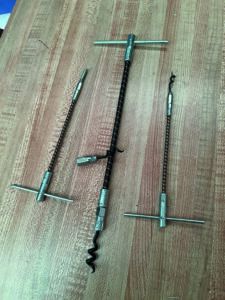
Enter the Palmetto 117 Packing Extractor Set, made in the USA by Palmetto Inc., based in Denton, MD. Also known as “Set B” on Grainger supply’s website (www.grainger. com), the combination of picks and screws is one of many professional grade tools and tool sets sold by Palmetto and available at multiple online retailers.
The device’s corkscrew is threaded into the handle so it won’t pull out, and the set also came with a set of screwon wood screws to embed in hardened packing that refuse to budge. In addition, the Palmetto Packing Extractor Set comes with three sizes of longhandled picks, and a small open-end wrench that allows you to rotate your tool of choice into the old packing. Our Palmetto 117 Packing Extractor Set was richly priced at $162.39, but we’ve yet to find a high-quality tool at the bottom of a discount bin.
This is our best choice among packing removal tool kits. If you do pick one of these up, you may soon find yourself with a lot more friends during haulouts.
ALLOY EXCEL ANCHOR
We’ve tested a slew of anchors over the decades and after years of design stagnation, things really picked up a couple decades ago with a new generation of deep setting anchors that relied less on sheer brawn and more on the angle of penetration and other design features to set and hold. This has opened the door for lighter-weight anchors that still deliver good holding and help shave a few pounds in the bow (music to the racer’s ears). Now that this approach has been perfected, anchor makers are subtly tweaking the design to improve holding.
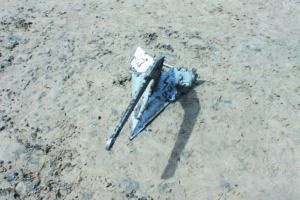
The Australian made Excel aluminum alloy anchor is not new, but after taking the time to dive into its design features and test it in a variety of bottoms last year, our testers felt it deserved a spot in the Gear of the Year awards.
Anchor performance is the result of complex interactions between balance and angles that are best evaluated through rigorous testing. No single feature—roll bar or not, convex or concave—can be considered in isolation. What counts is the anchor’s performance across a range of seabeds and through multiple resets. We’ve found that with the exception of soupy mud where you should never expect good holding, the Excel delivers high holding capacity and fast setting and resetting without clogging.
PS tester Jonathan Neeves has been using an Alloy #4 Excel as the primary anchor on his 42-foot Light Wave catamaran for many years, and he’s tested enough anchors to know what he likes. Our experience with the much smaller Excel #1 has been just as positive, outperforming much heavier anchors.
Rather than declare the Excel anchor as our all-around best choice, bar none (a move which would almost surely provoke an uncivil war online among proponents for various competing anchors) we do believe the alloy Excel has duly earned a Best Choice rating for a second anchor, or an ultra-light primary. For long-term cruising, the steel version is right up there with the best of the best.
GILL BOOT SOCK
Our resident chionophile and tech editor Drew Frye was back at it again this year, exploring the best clothing for cold wet sailing. After his rundown of wool socks (see PS May 2020, “Wool Sock Update,”), we started getting letters about waterproof socks, a topic we’d touched upon previously but not explored in depth. We found several good contenders, but the socks that kept us the driest and warmest throughout some fairly rigorous testing was the Gill Boot Sock.
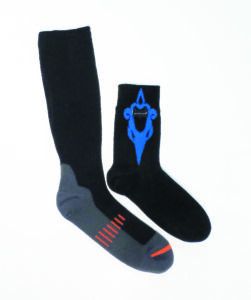
The boot height is a full knee sock, which seems like overkill, but the extra elastic band at the top insures they stay up, nothing can sneak over them, and they do keep your calves warm—a nice bonus. Thick and luxuriously wellpadded, these should make deck shoes comfortable deep into the fall.
We’d rate them as effective insulators down to about 40F with deck shoes, and slightly below freezing if conditions are dry. You can always add a pair of fleece or merino wool socks inside them if it gets really cold. Inside waterproof shoes or boots they add an extra level of security. These are our Best Choice in waterproof socks if you want to stay warm in all conditions.
WATERSHED
Watertight dry bags are practically essential to the cruising sailor. Sailors on small boats often press their cockpit lockers and other not-so-dry locations into service for storage of equipment like tools and clothing that can be ruined if they get wet. And then there’s the dinghy ride back to the boat with clean laundry. (Why does a squall always brew on laundry day?).
There are dozens of waterproof bags on the market and our test, which explored the pros and cons of different designs— duffels, backpacks, roll-tops, etc.—just scratched the surface. But the success of all of them hinge on the allimportant closure, and in this regard, one brand stood apart.
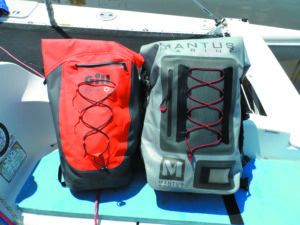
The distinguishing feature of Watershed’s well-made bags is their super-zip lock closure, which is completely waterproof. Although some of the Watershed bags combine this with a roll-top, the rolls are not required for watertight integrity. The open and close motion takes getting used to at first, but becomes second nature with practice. Downsides? These bags are a bulkier and little more expensive than competitors. We’ve never had much faith in any zipper-like closure, but we’ve used these for a couple of years without a hitch.
This is no surprise since Watershed focuses almost exclusively on waterproof containers. Their product line includes every imaginable special purpose bag you can imagine, from backpacks and duffels, to deck bags and gun bags.
We tested the Chattanooga (22 liters). It combines a roll-up closure with a Watershed closure, providing watertight insurance. It has fewer handles and fittings for lashing down than other duffels we tested, but is made from heavier fabric.
Watershed bags is our Best Choice when looking for a bag that provides perfect water tight integrity and extreme long life.
LUCK GRIB
We sent our intrepid delivery skipper Bill Herrmann around the tip of Florida to test weather routing programs that work with gridded binary weather files. These are the raw data from computer generated weather models that can be downloaded from a server via satellite (or via short wave, with the appropriate software). After rounding the tip of the Sunshine State, he came back with a winner as well as some insight into emerging technology that is taking the guessing out of passage planning.
Luck Grib takes data from your boat’s performance specifications—sailing polars and the motoring polar—as well as the Ocean Current GRIB and the Global Forecast System (GFS) GRIB, and then develops the a routing plan based on assumptions of when you’ll be motoring or sailing.
Luck Grib’s ability to support multiple GRIBs and recalculate without reconnecting to the server via satellite is a great advantage. This feature allows us to recalculate using existing GRIBs based on the vessel’s current location, maximizing our velocity made good.

The cost for Luck Grib is $25 for the base application, $50 for offshore module that allows for the satellite downloads and $50 for routing. If you do not plan on using the satellite feature, the cost is just $75 for the product. If heading offshore $125 is downright cheap
For recreational sailors, the new Luck Grib routing app is an incredible value. Experienced sailors can confirm their routing, and even seasoned sailors can see how what they thought was the best route might not be so smart after all.
CREW MANAGER
The racing sailors among us can attest to how challenging it can be to juggle crew schedules, so its no surprise that a number of scheduling apps are available to simplify this task. After testing the most commonly used options for this task – including some free shareware products—Crew Manager (crew-mgr.com) proved to be the most convenient and easy to manage. Crew Manager had several advantages:
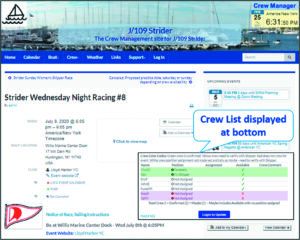
• The crew availability for a specific race date is better managed, with more capability to avoid too few or too many crew.
• When choosing among the crew who said ‘yes’ for an event, the software will total the individual crew weights.
• Are you short crew for an upcoming race? Skippers can create groups of people to reach quickly—for example, by designating a group as ‘foredeck qualified crew’, and then blasting a text message “Could anyone on this thread work the foredeck this Saturday, details here [link].”
• Even setting up a Zoom meeting becomes easier.
After a little while of use, you will find that reverting to old styles of communication to be inefficient and prone to errors. Crew Manager precludes people from losing information you email, and if you fall back to cutting and pasting between applications, you make mistakes, such as leaving out people. And that’s exactly what you don’t want to do when you’re hoping to build a good crew.
PS picks waterproof epoxies and tapes to protect against rope chafe.
One of the most interesting tests we conducted this year was a test of underwater patching compounds. This is the stuff you hope never to use. We applied various compounds to a leaky bucket, and then used them on various other repair projects involving immersed components, including the bonding fiberglass panels under water.
A similar project involved more preventative action. The aim was to identify tapes that could be used to prevent gel-coat or spar damage at points of chafe. These can be applied where genoa leads rub against a coaming on the way to the tailing winch, or at the front edge of the mast where sheets make contact at each tack.
SIMPSON FX-764
We’ve used this in industry to repair concrete wastewater tanks in the winter, and the National Park Service uses it to install in-stream monitors in icy trout streams. Although slow curing, it has the advantage of working down to 40 F and slightly below, which should be enough for arctic explorers. Bottom Line: The Best Choice for cold water sailors.
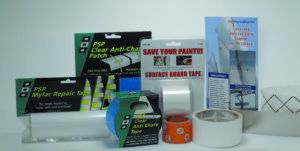
JB WELD WATERWELD
WaterWeld is sticky, completely non-sagging, and stiff enough to hold back water. This is what you’ll reach for when water is coming in. This was our Best Choice for stopping leaks and mounting bilge pump floats.
PSP ANTI-CHAFE TAPE
Looking for ways to protect our mast paint and gel coat from line friction we explored a variety of heavy-duty stick on protective tapes. Testers found the PSP anti-chafe tape to be very slippery, very chafe resistant, and easy to apply. We recommend it for applications where ropes or webbing must slide smoothly. It is available in thicknesses of both 130 microns (5 mils) and 250 microns (10 mils). It worked well where control lines run across cockpit combings and on the front of the mast, and it was a real winner on the underside of the boom, where it helped the clew strap outhaul more easily. The 5 mil is more flexible, but unless the curve radius is less than about 1/2-inch, the 10 mil works just fine. It is our Best Choice in anti-chafe tape.
Our recent in depth report on desiccating heads—also known by the misnomer composting heads—focused on two products designed to eliminate odor. The key to maintaining an odor free desiccating head, as anyone who owns one of these heads knows, is using a urine diverter (basically a funnel and a reservoir) to catch the urine and separate it from the solid waste. While solid waste is most often associated with odor, any health care worker can tell you that the ammonia odor of urine can be overwhelming if left untreated.
NILODOR URINE DIGESTOR
Unlike a holding tank, where the purpose of treatments is to support a healthy biome, the best urine treatments aim to stop bioactivity dead. Urine treatments modify the urine chemistry so that fermentation cannot take hold, and any ammonia that is generated will be retained in solution.
Like holding tank or portable toilet treatments, the greater portion of the treatment is added to the urine reservoir before use. However, just as we recommend spraying a diluted odor treatment in the bowl of holding tank-type heads (see PS June 2017, “A Simple Solution to Toilet Bowl Stink”), the urine diverter can also benefit from a light spray of urine treatment after each use to prevent the build-up of scale and stains and to prevent odor from the funnel surface itself.
Very few of the products that claimed to reduce urine odor actually worked, save one—Nilodor, which is also used in hospitals and long-term care facilities. Nilodor includes a mild fragrance that gives it a barely noticeable citrus odor. Testers detected no odor for the first two days after treatment, only the mild fragrance of the product. For 7 days after treatment, the odor remained mild, less conspicuous than samples treated with vinegar and citric acid, and orders of magnitude better than raw or sugar-treated urine. When diluted as directed (1/4 cup per gallon of holding tank, or 1 tablespoon per pint to use as a spray), it doesn’t require an excessive amount of storage space. Add a little Febreeze or other odor neutralizer if you like.
WOOD ASH (OR ASPEN SHAVINGS)
The solid media in a desiccating toilet serves several purposes. It provides visual cover over solid waste, and draws moisture away from the solids. Good wicking and coating are more important than absorption, since sustained drying is the goal. It helps filter the air moving through the system, which is why fuzzy fibers and organic materials help. If you compost with your treated solid waste, bulk and biodegradability are additional features to look for.
We tried several of the favorites for a week each and came up with a winner—wood ash. Wood ash has a high pH. This provides both a surface bio-stat and enhances dehydration, resulting in the best odor control of any product tested. It is also potentially the messiest, but if you have wood burning stove or fireplace that generates wood ash, using this in your desiccating toilet is a no-brainer. Wood ash is high in phosphorous and increases the pH, improving its utility as a compost. Aspen wood shavings came in a close second.

Our long-term test of wood finishes featured several new and interesting products, but when categorized by type of finish the results didn’t diverge sharply from what we’ve found in the past. Two part polyurethanes still rule the roost in terms of durability, but single parts make touch ups and refinishing much easier. As for synthetic single-part tinted finishes, they provided longevity, easy application, quick recoating and, because they lack the shiny gloss of the other coatings, will find favor among sailors who like to preserve the natural look of wood. One of the top rated products in our test used a combination of tint and two-part urethane to deliver a finish that appeared nearly as good as it did when first applied.
AWLWOOD
Awlwood’s fast-curing, two-step system involves a coat of primer (clear, yellow, or red) plus multiple coats of a topcoat (satin or gloss). You can add a special reducer to control flow. The initial tinted layers enhance the wood’s natural coloring and penetrate the wood to ensure a uniform substrate. The gloss provides UV protection.
After 24 months in the Florida sun, all three of the Awlwood samples maintained outstanding color retention— the difference between the exposed and unexposed areas was nearly indistinguishable.
For ease of application, color preservation, gloss, and durability, Awlwood is hard to beat. All three samples were clearly among the best in our comparison.
EPIFANES WOODFINISH GLOSS
For those who prefer traditional varnish, Epifanes Woodfinish Gloss scored high. With a tung-oil and phenolic-modified-resin base, the varnish has a slightly amber hue, but cures with a clear finish. It’s quick to apply (fewer coats are required and there’s no sanding between coats within 72 hours). Woodfinish gloss was the best among the Epifanes’ finishes, narrowly edging out Epifanes other top shelf finish, Clear Gloss.
PETTIT FLAGSHIP AND CAPTAIN’S VARNISH
Two Pettit Z-spar products rose to the top in this test, Flagship #2015 and Captain’s Varnish #1015. Both are one-part varnishes from the company’s Z-Spar product line, and both were Recommended products at the 18-month mark in our last test.
Both the amber-colored Captain’s and the warm-hued Flagship are well-regarded as traditional spar varnishes, combining phenolic and alkyd resins with tung and linseed oils. Application is relatively easy. After two years, both rated Very Good for gloss. Both retained color extremely well. The 1015 Captain’s Varnish was also one of the most economical coatings in the test.
































